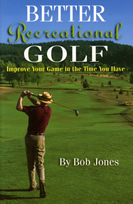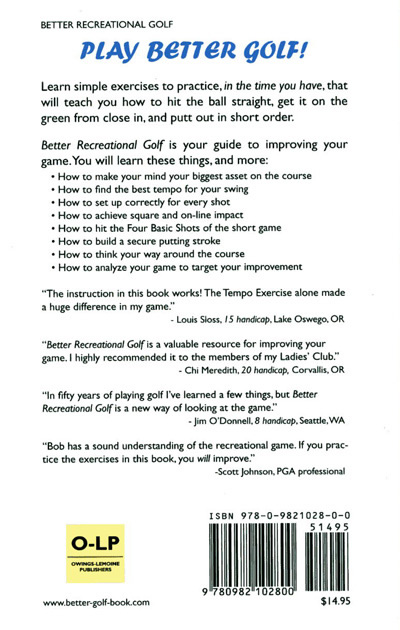 |
BETTER RECREATIONAL GOLF Improve Your Game in the Time You Have Author: Bob Jones Reviewer: John K. Darling, founder of Senior Friendly Golf LLC |
Some how Bob found my email address and sent me a message about his new book. I returned his message requesting a copy to review and what do you know, he sent me a copy. Upon receipt I emailed him back promising to review it on my trip to Lyon, France. So here it is.
The very first thing that struck me, as my Northwest Airliner took off over the Atlantic to Amsterdam, was that this was going to be a book about specifics and to improve your game it was going to take time. Like the subtitle says, "improve your game in the time you have." What came through in the first few pages was that it is going to take "commitment" as well. With this book's advice, you will likely improve your game to the extent you are willing to dedicate a specific amount of your time to a specific schedule of practice and play.
The only unfortunate advice he gives is to practice at home. I live in the foothills of Colorado. If you don't have a lawn, you may be out of luck. Not necessarily, though. There are several companies that make golf balls you can actually hit inside your house without the danger of knocking over and breaking things…at least with your chip shots. (See the PRODUCT REVIEW. Also, THE COMPREHENSIVE GUIDE TO A SUCCESSFUL FUND RAISING GOLF TOURNAMENT gives access to over 100 sources of golf products and services) Bob's book is filled with photo illustrations that will help you along your way to better golf.
I love the fact, on the first page, where he identifies the four broad basic skills of golf and then develops how to get there. Here they are: have a calm mind, hit the ball straight, get the ball on the green from short ranges, and get the ball in the hole quickly once it's on the green.
Right off the bat, or club as it is, on page four he provides a ball flight chart. This chart will identify how your club head is positioned as it contacts the ball when you have a consistent smooth swing. That alone will teach you a lot. Every shot you hit will either go right, left or straight.
Chapter two goes into, "consistency," which is accomplished with a "calm mind" over every shot. Consistency, along with "concentration," has always been my Achilles heel. Bob likes to number his advice. Not a bad idea. You can pick a number and work on perfecting it. He suggests you write down what you want to practice and note accomplishing those objectives after each practice session. Not accomplishing your objectives is not an option. Practice until you are successful with whatever you choose for each session. The other three fundamentals are set up, tempo and rhythm, and swinging instead of hitting at impact.
A calm mind. This deals with "visualizing" and getting mind and body working together, as every shot is like a snowflake and is different depending on circumstances at the time. It reminds me of advice in an old book, PSYCOCYBERNETICS by Maxwell Maltz. In his book two basketball teams went on the court and one shot baskets for a period of time and another went on the court and visualized shooting and making baskets for the same period of time. There was very little difference in the results when the exercise was repeated with both teams shooting baskets. Of course with golf, the trajectory and how you achieved it will call for actually practicing with real golf balls or short-range golf balls designed to mimic actual golf balls. A company, Birdie Ball www.birdieball.com, makes a substitute ball that will go only about 40 yards yet yields the same flight pattern as an actual ball.
Chapter three is The Long Game. With every shot he starts with your set up, beginning with the grip and moving into your stance and posture with specific checkpoints. Next proper aim, alignment and ball positioning. How to start are discussed and an at-home baseboard exercise is presented. He moves on to the swing finish. Tips on how to practice your swing at home and on the range are set fourth, and the chapter ends with four principals of the Long Game. I like number four best. "Put accuracy above distance."
Moving on to chapter four, Putting. I don't know why he put putting before the Short Game chapter, but it's never too early to discuss putting. This is where total scores are made or not. Did you know putters have a sweet spot? Now a days most of the expensive ones claim big sweet spots. This chapter tells you how to identify its sweet spot. The stance, grip, and how to stroke the ball is revealed. Only one type of grip is shown. How to read the green is an important section of this chapter as well as pre-putt routines. Bob gives a number of putting exercises and ends the chapter with four; there it is again, "four" principles of putting. I like the first principle best. "You are as good on the green as you believe you are."
Chapter five is The Short Game. It would be wonderful if we all could get to greens in regulation. Of course this is not going to happen so the short game becomes a must to even think of breaking 100, 90, 80, etc. Three types of basic chip shots are discussed with photos followed by various pitch shots including from the rough and bunkers (sand traps). Specialty shots and learning new shots ends the chapter along with four principles of the Short Game. As always, the first of the four concerns a "calm mind."
Chapter six is Playing the Game. This chapter discusses the importance of hitting each shot to position the next. It also emphasizes having a game plan before you tee off on the first hole. This reminds me of another book, THE MULLIGAN by Wally Armstrong and Ken Blanchard. This book suggests that you establish what the score is that you intend to make on each hole and not be chained to the "par" score on the scorecard. Your made up par may be five on some four pars. Eventually, you will be expecting a par on each hole as printed on the scorecard. Warming up on the range, putting green, choosing the right tees, marking your ball, what clubs to use when and where, and many other important subjects are presented to get you prepared for an enjoyable and satisfying round. Basic golf etiquette and rules are included. There are two basic rules of recreational golf. The first is knowing that you will have the most fun if you play well and the second addresses self-worth.
Chapter seven is Supporting Your Game. Ideally you will use a digital camera to document your swing with a 9-iron, 5-iron and a driver. Using two cameras at the same time will be even more helpful for future review. Learning the distance you usually hit with each of your irons will be very important as you get on the course. There is a product on the market, "Stick Tips" that has stickers for both yardage and reminders (slow back swing, etc.) to stick on the shaft of each of your clubs. Analyzing your game can be done by making notes on various aspects of each round you play. GOLF DIGEST has a program on line that will help you with this. I personally make notes on my scorecard to record hitting the fairway on tee shots, greens in regulation, and number of putts on each hole. BETTER RECREATONAL GOLF goes even deeper as well as telling you how to get the most out of golf lessons. There is also a suggested list of books to read and keep to refer to from time to time. Many of these books are written by famous professionals and date back as far as 1946. Some names you may not recognize but the advice given in them all will get you back on track when your game goes astray.
The last chapter, chapter eight, is Summary. This chapter is especially useful because it lists main points in the book and the page numbers to refer back to. The index is also useful to spot reference pages to deal with specific aspects of your game.
BETTER RECREATIONAL GOLF is best used as an improvement vehicle for high handicap and bogie golfers and not for beginners who are starting the game for their first time. In those cases I recommend a four to six lesson package with a teaching professional to begin with. A group clinic with other beginners would be just fine. This will teach the broad fundamentals and then this book will sharpen one's game.
$14.95. Order on line www.better-golf-book.com.
Owings-Lemoine Publishers at OLP@wvi.com for quantities.
